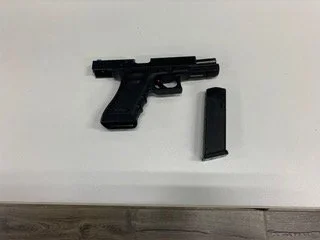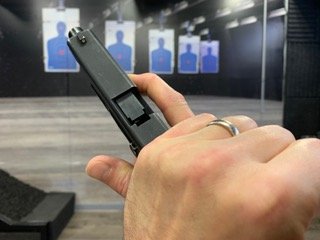There are an estimated 450 million privately-owned firearms in the United States. Yes, that means more firearms than people. The average firearms owner has five to ten firearms, from shotguns to handguns to rifles, and all of them should be safely and securely stored when not in use. Not simply stored to keep the firearm secure and out of reach of untrained family members, but also to prevent degradation to the firearm from time and elements.
Think Twice about Defense Before International Travel
Recently, I got a call from a man preparing for international travel to Africa. He was very concerned with getting permitted and purchasing a firearm in the US before leaving, plus getting as much practice as possible. While I initially just suggested options for permits and training, I suddenly realized he was preparing to purchase a handgun to take with him, in his luggage, to Africa.
Whoa whoa whoa! Planning to take your US gun to Africa? Nope. Dead halt here, I said. Unless you have permission from that country to bring your firearm, this makes you an illegal arms trafficker. Welcome to prison.
The gentleman was a bit confused. He said, but if I have a permit for a firearm, then it’s legal to carry it, right?
Holy moly. No. Not in a foreign country. That’s when I realized that I needed to write this blog post.
Gun Ownership in Other Countries
Let’s start with the basics here. In the vast majority of the world, you do not have the right to own a firearm, and in many places you do not have the right to self-defense at all!
In France, as an example, when a homeowner defended himself with a hunting shotgun against four violent home invaders, all armed with machetes, the homeowner was charged with homicide and assault for defending himself. The President of France, Emmanuel Macron himself, addressed this situation of armed defense saying that no civilians in France have the right to lethal self-defense.
In the United Kingdom, if you have pepper spray, you are charged under the same statues as having an illegal firearm. In fact, according to the UK’s laws on knives, “pointy objects carried for defense are considered offensive weapons” and you can be charged with their possession.
In Canada, our neighbor to the north, if you use lethal force to defend yourself, you are often charged with assault, as there is no guaranteed right to self-defense in Canada either.
Thank God for the Founding Fathers. We in the United States have the natural right to self-defense, and thanks to the Second Amendment, we can do so with the most effective tools possible, firearms, but this is the great rarity in the world, not the rule.
Defending Yourself when Traveling Internationally
So what do we do if we have to travel internationally, knowing that we’re going to be forcibly disarmed when we leave the US?
Research the laws in the country where you are traveling.
Develop a complete system of situational awareness to avoid trouble.
Understand how to find and use covert defensive tools, which would not be considered defensive under normal circumstances.
Research the laws in the country where you are traveling.
The weapon laws will vary from country to country. While in the UK even “pointy objects” are banned, in other countries knives, pepper spray, and even batons are perfectly legal. Make sure that you check with your airline about proper storage of this equipment in transport, and ideally, don’t let anyone know that you have these tools whatsoever. That means learning how to carry these tools covertly and how to deploy them from these hidden areas quickly.
Develop a complete system of situational awareness.
Situational Awareness is undoubtedly your best defensive tool, both at home and abroad. According to the Force Science Institute, you need three elements to survive a lethal force encounter: automatic defensive skills, a blueprint of violence and how it evolves, and assumptions about violence to help you spot the threat early.
Situational Awareness is about this third point: identifying threats at a distance and avoiding conflict. The goal here is learning to spot the behaviors and actions of potential threats so you can take the smallest actions possible to avoid a confrontation. This includes assessing the capability of a threat to cause you harm, either with a weapon or without, as well as assessing the intent of the threat to determine if they are sizing you up as their next victim.
If you can read and assess the threat, you can also give off the signals that you are aware and ready to act. That preparation, by itself, is often enough to deter the threat. I developed Defender University and the Pre-Fight Situational Awareness Training found there, just for this purpose.
Understand how to find and use covert defensive tools.
Defensive tools exist everywhere, provided you have the ability and will to use them. I don’t just mean knives and firearms – think more broadly. What about an aluminum water bottle with a netting of paracord around? Now you don’t have just a water bottle, you have a flail. How about a small cable lock that you could use to secure a cabinet or locker, or a bike lock with paracord? Again, a flail. There are umbrellas with solid metal cores that can act as batons. Having a cane is another excellent striking tool. Beyond the obvious tactical pen (which I highly recommend), any other high-quality pen with a metal body can be a highly effective stabbing tool, since the tip of a ballpoint pen is sharper than a dog’s tooth. I learned from a Navy Seal that taking up knitting gives you a fantastic excuse to keep long pointy needles on-hand for travel. You get the idea.
The man who originally called me was heading to Africa for a mission trip. My suggestion to him was very simple: get a toolbelt with a quick draw slot for a hammer. No one will look twice at a missionary carrying a hammer, and that’s an outstanding defensive tool. Be aware that your reason for travel will dictate what tool may be appropriate as much as the country you’re planning to visit..
There are a lot more suggestions for covert defensive tools online. Check out Ed Calderon and his classes for a lot more suggestions and techniques.
Be safe on any foreign travels. And God bless America for the Second Amendment.


















